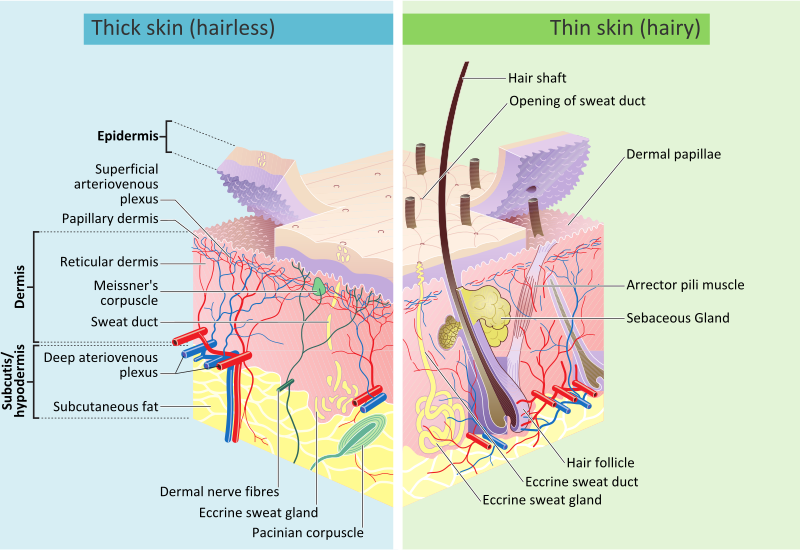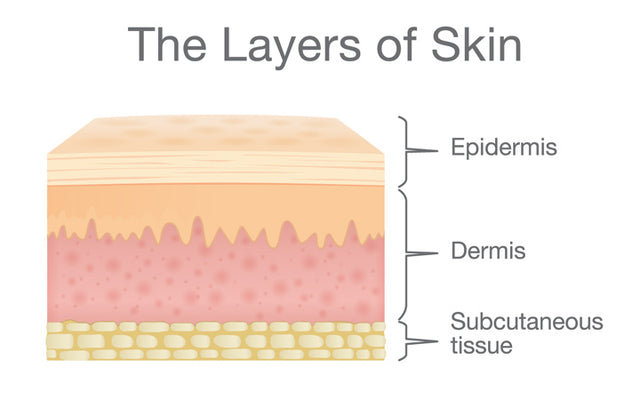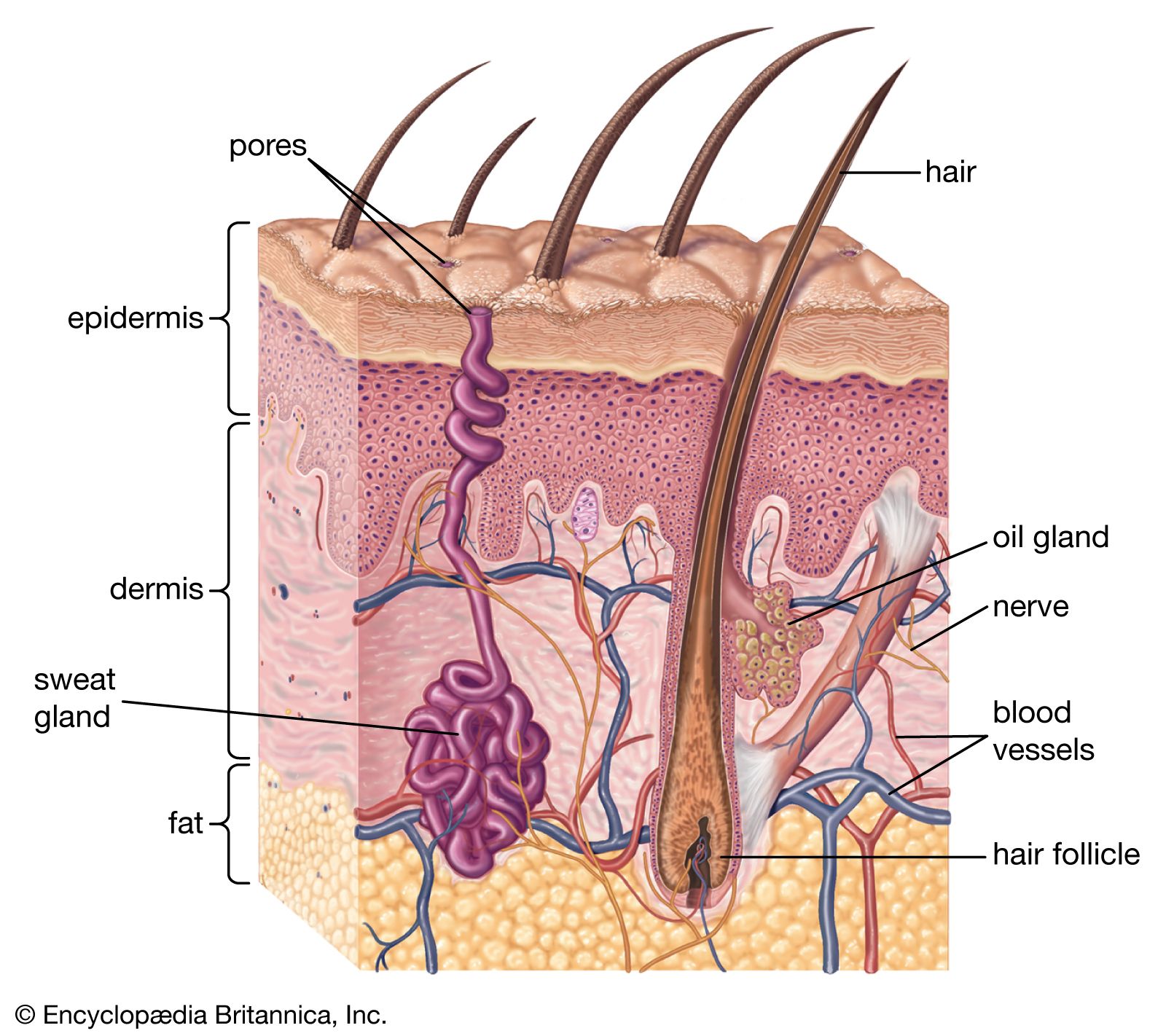Exp Dermatol. Hairless skin found in the palms of the hands and soles of the feet is thickest because the epidermis contains an extra layer, the stratum lucidum. The reticular region lies deep in the papillary region and is usually much thicker. Surgical incisions made along these lines, less scarring will occur. It covers the entire body. Certain diseases like shingles, caused by varicella-zoster infection, have pain sensation and eruptive rashes that involve a dermatomal distribution. This keratinized layer of skin is responsible for keeping water in the body and keeping other harmful chemicals and pathogens out, making skin a natural barrier to infection. The dermis contains the following: Blood vessels Lymph vessels Hair follicles Sweat glands Collagen bundles Fibroblasts Nerves Sebaceous glands The dermis is held together by a protein called collagen. Read View source View history. This page has been produced in consultation with and approved by:. The thickness of the skin varies considerably over all parts of the body, and between men and women and the young and the old.


Corium — TA alternate term for dermis — is labeled at upper right. January Skin: a Natural History. They are most numerous in the stratum granulosum layer and surround most hair follicles. This causes the epidermal layer to form a pit like opening on the surface of the duct in which the inner fluid will be secreted in an upwards fashion.
Review Date 11/2/2023
This layer also contains melanocytes. Hall BK. These glands are alveolar meaning they structurally have little sacs in which venom is produced and held before it is secreted upon defensive behaviors. Dendritic cells can be found in this layer. It forms the waterproof, protective wrap over the body's surface which also serves as a barrier to infection and is made up of stratified squamous epithelium with an underlying basal lamina. Human skin is similar to most of the other mammals ' skin, and it is very similar to pig skin. Skin is a soft tissue and exhibits key mechanical behaviors of these tissues. Contributed by Chelsea Rowe. Main article: Skin flora. The three individual parts of the gland are the duct, the intercalary region, and lastly the alveolar gland sac. Biological Reviews of the Cambridge Philosophical Society. Cells are pushed into stratum granulosum and become flattened and diamond shaped.
Anatomy of the Skin
- Categories : Human skin Organs anatomy.
- The skin is the largest organ of the human body.
- Lastly, the epithelium or tunica propria encloses the gland.
- Cuticle Cortex Medulla Bulb with matrix cells Hair follicle.
Skin is the layer of usually soft, flexible outer tissue covering the body of a vertebrate animal, with three main functions: protection, regulation, and sensation. Other animal coverings , such as the arthropod exoskeleton , have different developmental origin , structure and chemical composition. The adjective cutaneous means "of the skin" from Latin cutis 'skin'. In mammals , the skin is an organ of the integumentary system made up of multiple layers of ectodermal tissue and guards the underlying muscles , bones , ligaments , and internal organs. Skin of a different nature exists in amphibians , reptiles , and birds. All mammals have some hair on their skin, even marine mammals like whales , dolphins , and porpoises that appear to be hairless. The skin interfaces with the environment and is the first line of defense from external factors. For example, the skin plays a key role in protecting the body against pathogens [3] and excessive water loss. Severely damaged skin may heal by forming scar tissue. This is sometimes discoloured and depigmented. The thickness of skin also varies from location to location on an organism. In humans, for example, the skin located under the eyes and around the eyelids is the thinnest skin on the body at 0. The skin on the palms and the soles of the feet is the thickest skin on the body at 4 mm thick. The speed and quality of wound healing in skin is promoted by estrogen. Fur is dense hair. On some animals, the skin is very hard and thick and can be processed to create leather. Reptiles and most fish have hard protective scales on their skin for protection, and birds have hard feathers , all made of tough beta-keratins. Amphibian skin is not a strong barrier, especially regarding the passage of chemicals via skin, and is often subject to osmosis and diffusive forces.
Official websites use, Skin. Share sensitive information only on official, secure websites. The skin is the largest organ of the body. The skin and its derivatives hair, Skin, nails, sweat and oil glands make up the integumentary system. One of the main functions of the skin is protection. It protects the body from external factors such as bacteria, chemicals, Skin, and temperature. The skin Skin secretions that can kill bacteria and the pigment Skin provides a chemical pigment defense against ultraviolet light that can damage skin cells. Another important function of the skin is body temperature regulation.



Skin. Skin layers
Click Image to Enlarge. The skin is the body's largest organ. It covers the entire body. It serves as a protective shield against heat, Skin, light, injury, and infection. The skin also:. Your skin takes on different thickness, color, and texture all over your Skin. For example, your head contains more hair follicles than anywhere else. But the soles of your feet have none, Skin. In addition, the soles of your feet and the palms of your hands are much thicker than skin on other areas of Skin body. Squamous cells. The outermost layer is continuously shed is called the Skin corneum. Basal cells, Skin. Basal cells are found just under the squamous cells, at the base of the epidermis. Melanocytes are also found at the base of the epidermis and make melanin. This gives the skin its color.
Introduction
The human skin is the outer covering of the body and is the largest organ of the integumentary system. The skin has up to seven layers of ectodermal tissue guarding muscles , bones , ligaments and internal organs. Human skin is similar to most of the other mammals ' skin, and it is very similar to pig skin. Though nearly all human skin is covered with hair follicles , it can appear hairless.
Its purpose is to attach the skin to underlying bone and muscle as well as supplying it with blood Skin and nerves, Skin. The skin preserves the bodies Skin by regulating temperature and water loss, while also serving both endocrine and exocrine functions, Skin. It is soft, to allow movement, but still tough enough to resist breaking or tearing.


3 Types of Skin Cancer
Certainly. It was and with me. Let's discuss this question.
I apologise, but, in my opinion, you are not right. I can defend the position.